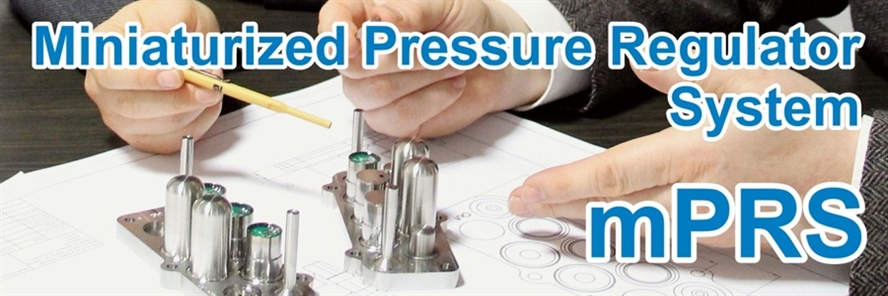

Objectives
The “mPRS” project comprises the development of a miniaturized pressure regulation system with ultra low leakage, high reliability and an end-of-life venting capability (passivation) of tanks.
Most of the space propulsion systems require a pressure regulation system (PRS) to have a constant inlet pressure of the propellant feed system. In the case of chemical propulsion systems the constant pressure is needed to repressurize the tanks as a prerequisite of a constant propellant flow. A PRS is also required for cold gas or electric propulsion systems. In this case the PRS provides the propellant flow either directly to the thrusters or to the inlet of subsequent flow control units.
Common to all applications is the need, to reduce the tank pressure of several hundred bars at begin of mission, down to a low pressure between 1 and 20 bars to supply the thrusters. The PRS is a core element that is critical for mission success. Therefore a high reliability strategy with internal redundancies is mandatory.
The target mission for the mPRS can be split into two categories:
For chemical propulsion systems a high flow system with gas flows of up to 25000 sccm at an outlet pressure of 20 to 30 bar will be required. The media is Helium at a tank pressure of up to 350 bar.
The second scenario is a xenon fed electric propulsion system. This requires a tank pressure of 180 bar and an adjustable outlet pressure between 0.1 and 3 bar. The typical gas flow would be in the range from 1 sccm full scale for micropropulsion up to 200 sccm for high power thrusters. The upcoming full electric satellites furthermore ask for a much higher flow of 1000 sccm to 2000 sccm to supply Xenon cold gas thrusters from the same low pressure node.
The project objectives are defined as:
1. Provide miniaturized high pressure valves of European origin
2. Provide a high pressure flow path board of European origin
3. Provide miniaturized high pressure sensors of European origin
4. Provide an advanced miniaturized pressure reduction system of European origin
5. Reduce the internal leakage of flow components to less than 10-6 scc/s GHe
6. Proof the feasibility of subsystems made of fluidic surface mounted devices for high pressure applications
7. Reach TRL5+ for the mPRS unit
All seven objectives are long term goals of the project.
Most of the space propulsion systems require a pressure regulation system (PRS) to have a constant inlet pressure of the propellant feed system. In the case of chemical propulsion systems the constant pressure is needed to repressurize the tanks as a prerequisite of a constant propellant flow. A PRS is also required for cold gas or electric propulsion systems. In this case the PRS provides the propellant flow either directly to the thrusters or to the inlet of subsequent flow control units.
Common to all applications is the need, to reduce the tank pressure of several hundred bars at begin of mission, down to a low pressure between 1 and 20 bars to supply the thrusters. The PRS is a core element that is critical for mission success. Therefore a high reliability strategy with internal redundancies is mandatory.
The target mission for the mPRS can be split into two categories:
For chemical propulsion systems a high flow system with gas flows of up to 25000 sccm at an outlet pressure of 20 to 30 bar will be required. The media is Helium at a tank pressure of up to 350 bar.
The second scenario is a xenon fed electric propulsion system. This requires a tank pressure of 180 bar and an adjustable outlet pressure between 0.1 and 3 bar. The typical gas flow would be in the range from 1 sccm full scale for micropropulsion up to 200 sccm for high power thrusters. The upcoming full electric satellites furthermore ask for a much higher flow of 1000 sccm to 2000 sccm to supply Xenon cold gas thrusters from the same low pressure node.
The project objectives are defined as:
1. Provide miniaturized high pressure valves of European origin
2. Provide a high pressure flow path board of European origin
3. Provide miniaturized high pressure sensors of European origin
4. Provide an advanced miniaturized pressure reduction system of European origin
5. Reduce the internal leakage of flow components to less than 10-6 scc/s GHe
6. Proof the feasibility of subsystems made of fluidic surface mounted devices for high pressure applications
7. Reach TRL5+ for the mPRS unit
All seven objectives are long term goals of the project.